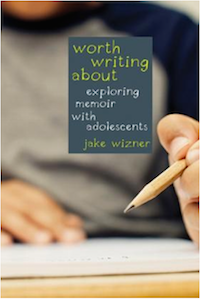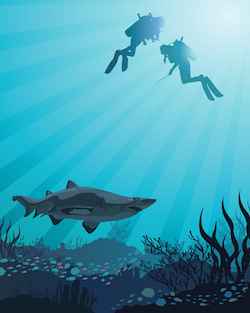How to Teach Memoir in the Middle Grades
I stand in front of my eighth grade class, excitement and anticipation washing over me. It is the beginning of the memoir unit, and I know that the next two months will be the most memorable and most meaningful work we do all year.
I tell my students how excited I am. I tell them that by the end of the unit most of them will produce the best piece of writing they have ever produced, and many of them will have come to see themselves and their lives in new ways.
They look at me skeptically. How do I know this will happen? I know it, I say, because it happens every year.
There are many reasons – both academic and social-emotional – why it is so worthwhile to teach memoir writing to adolescents, but here I want to focus on the how. How do I help students who say they don’t remember anything well enough to write about it? How do I get them to dig deep and uncover the themes in their lives? How do I help them elevate the craft of their writing? For teachers embarking on a memoir writing unit, there are three fundamental ideas about the genre that I find myself returning to again and again.
► Memoirs do not need to be factually accurate, but they need to be truthful.
► Every story must have an understory.
► Memoirs should move seamlessly between the sea and the mountain.
1. Sorting Out Fact and Truth
When I was young, maybe five or six, my father took me to play in the park, and a dog bit me. I took this memory and developed it into a memoir for a high school writing assignment. Since I didn’t remember exactly what had happened, I had to make up most of the details – the words that my father and I spoke to each other, the appearance of the dog, what I was feeling at the time. I didn’t purposely lie; instead I recreated the events as I imagined they might have occurred.
We need to approach memoir with the understanding and with the acceptance that memory is imperfect. That’s okay, because when we tell our stories, our goal is not to get everything exactly “right,” but rather to recreate our past experiences in a way that reveals larger truths about our lives and about who we are. In the case of my story, what mattered most was being able to convey how I viewed my father at the time, and how this incident made me realize that he would not always be able to keep me safe.
When students come to understand that the inadequacy of memory is not so much a limitation as it is an opportunity to shape their stories as they see fit, they begin to feel liberated and are able to move forward in their work of looking back.
2. Telling the Understory
My first year of teaching memoir writing, I had a student who wrote about a day he spent at Coney Island with his mother when he was five. He described the rides and attractions in great detail. He talked about eating Nathan’s hot dogs. He did an excellent job providing a play-by-play account of what happened that day. What he did not do was convey why this day was worth writing about.
“It just stands out in my memory,” he said, during our conference.
I continued to ask questions and to listen, and soon this student was speaking about his relationship with his mother, about how she worked all the time and he rarely saw her, how this was a day when he saw another side of her that he rarely saw growing up. By the time he turned in his final draft, the memoir had become something much more than just the recounting of a day at Coney Island. It had become a moving and powerful story of the relationship between a boy and his mother.
Every memoir – every good memoir – needs to be about more than just the events it recounts. I call this added layer the “understory” because it signifies that there is something lurking beneath a story’s surface, a deeper significance, and it is our job as writers to bring it forth.
A memoir’s understory will dictate which details to emphasize when we tell our story, and which details to leave out. When I wrote about being bitten by a dog, I included many details about my relationship with my father because that was what my memoir was really about. If my understory had been something different – for example, how growing up is about taking risks – then I would have made different choices.
When I discuss what it means to have an understory in memoir, it is really the same thing as discussing theme in literature. Mark Twain’s The Adventures of Huckleberry Finn is much more than just an adventure story about a boy and a runaway slave rafting down the Mississippi River. Much of the book’s brilliance comes from the way in which the author uses the story to comment on questions of freedom, racial prejudice, the collision of law and conscience, and other issues society was grappling with at the time.
When we effectively weave together story and understory in our memoirs, we open a window into the our lives and illuminate something deep and meaningful about who we are.
3. Atop the Mountain, Into the Sea
On the board, I draw a picture of a mountain overlooking the sea. A lone figure stands perched atop the mountain’s summit and another swims among the waves below.
“What does this picture have to do with writing memoir?” I ask my students.
What I want to convey is the different ways the two people view the ocean, how the swimmer is assaulted by his immediate surroundings – the cresting waves, the floating seaweed– while the person on the mountain sees the big picture, the water stretching endlessly toward the horizon.
When we write memoir, we want to move back and forth between the sea and the mountain. That is, we want to zero in on the sights and smells and sounds and feelings of past moments in such detail that our readers can fully experience these moments for themselves. At the same time, we want to zoom out from these moments and reflect on how and where they fit into the grand scheme of who we are and the lives we’ve lived.
Before I ask students to integrate these perspectives, I spend time teaching them to write from each one individually.
Writing from the sea involves re-creating past incidents as scenes, using dialogue, descriptive action, access to the character’s thoughts and feelings, and sensory detail to bring the reader into the middle of what is unfolding.
Writing from the mountain means asking ourselves: What do I understand now about this story and about myself that I did not understand when I was living through it? Sometimes we can express these more mature understandings explicitly, with sentence starters like, “I now realize…” or “What I have come to understand…” More often, mountaintop writing is just observations and insights woven into the story that the character was probably not consciously aware of at the time or would not have been able to articulate.
Teachers of writing should live writerly lives
Fact and truth, story and understory, sea and mountain – over the years, I have returned to these three ideas again and again to help my students write deeply and meaningfully about their lives. I have also returned to these ideas again and again in my own memoir writing.
Because as much as we focus on how best to teach our students, we should never lose sight of the fact that one of our most powerful tools is to live writerly lives ourselves. When we do the work we’re asking our students to do, when we try out the prompts, and share our drafts, and recognize the challenges, we become both better writers and better teachers of writing.
Perhaps most important, when we open windows into our own lives and share our stories of who we are, we inspire our students to do the same.
Read a MiddleWeb review of Worth Writing About









































Loved this book! Best book on teaching memoir to young people I’ve ever read.
Thanks so much! I love these key concepts–what a clear way to get across important ideas!
Constantly have to practice our craft. Great reminders and guidelines. I like the mountain and the sea analogy. Wonderful way to explain details vs. theme or big picture.